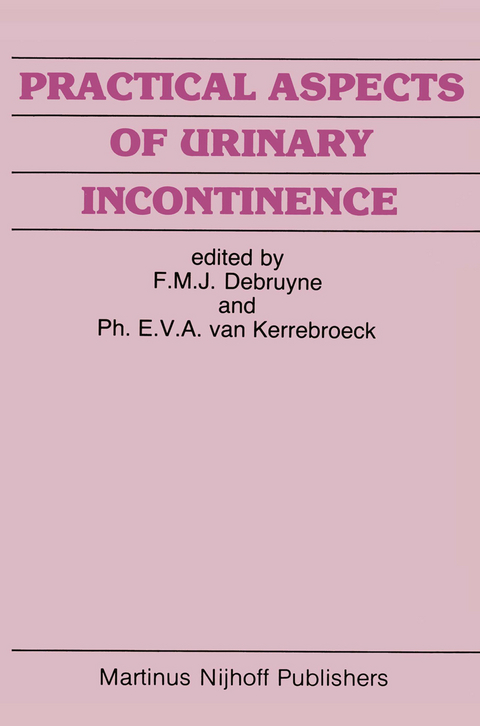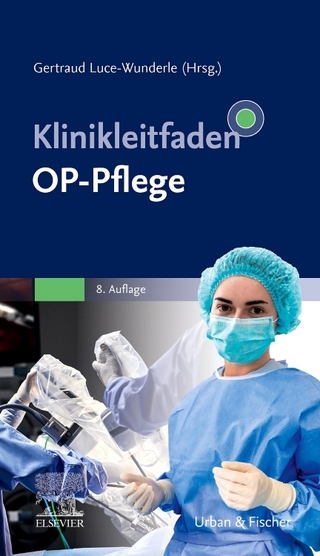
Practical Aspects of Urinary Incontinence
Springer (Verlag)
978-94-010-8381-2 (ISBN)
Introduction: Problems in the management of urinary incontinence.- One: Investigations for Urinary Incontinence.- I.1. Practical equipment for office urodynamics.- I.2. The role of radiology in urodynamics.- I.3. The value of the urethral pressure profile.- I.4. The role of telemetry in the evaluation of incontinence.- I.5. New developments in urodynamic investigations.- Two: Genuine Urinary Stress Incontinence.- II.1. The female sphincter mechanisms and their relation to incontinence surgery.- II.2. The rational approach for the surgical treatment of urinary stress incontinence.- II.3. A simplified technique of bladder neck suspension with tissue glue.- II.4. Transurethral teflon injection for stress incontinence in women. A critical evaluation after three years.- II.5. Burch colposuspension: method of choice?.- II.6. Turner-Warwick vagino-obturator shelf urethral-repositioning procedure.- II.7. Vaginal plasty operation for stress incontinence using fascia lata substitute.- Three: Recurrent Urinary Stress Incontinence.- III.1. Recurrent urinary stress incontinence: evaluation and therapy.- III.2. The treatment of recurrent urinary stress incontinence: a urologie view.- III.3. The treatment of recurrent urinary stress incontinence: a gynaecological view.- III.4. Recurrent urinary stress incontinence treated fascia sling plasty: technical considerations and results.- III.5. Practical aspects of vaginal sling plasty in the management of recurrent urinary stress incontinence.- III.6. Critical analysis of the role of surgery in the management of recurrent urinary stress incontinence.- Four: Incontinence and Resolutions of Vaginal Prolapse.- IV.1. Anterior vaginal repair for urinary incontinence associated with vaginal prolapse.- IV.2. Anterior colporrhaphy for urinary incontinence associated with vaginal prolapse: a gynaecological view.- IV.3. The surgical possibilities and limitations of the vaginal approach.- IV.4. Essentials of the technical aspects of anterior colporrhaphy and colpoperineal plastic repair: a gynaecologic procedure.- IV.5. Criterial review of the surgical techniques in the management of vaginal prolapse and urinary incontinence.- Five: Vesico-Vaginal Fistulae.- V.1. Female incontinence due to urethro- and vesico-vaginal fistulae.- V.2. The omental repair of complex vesico-vaginal fistulae.- V.3. Technical considerations in the vaginal approach of vesicovaginal fistulae.- Six: Male Incontinence.- VI.1. The sphincter mechanisms of the male and the prevention of postprostatectomy incontinence.- VI.2. Postprostatectomy incontinence.- VI.3. The mechanisms of continence and incontinence after prostatectomy.- VI.4. Incontinence operation for postprostatectomy incontinence.- VI.5. Critical analysis of the surgical procedures in the management of postprostatectomy incontinence.- Seven: Artificial Sphincters in the Management of Urinary Incontinence.- VII.1. The bladder neck artificial sphincter.- VII.2. Bulbar artificial sphincter.- VII.3. The implantable artificial urinary sphincter in children: a 6-year experience.- VII.4. The penoscrotal sphincter to treat male sphincter insufficiency.- Eight: Past and Future of Urinary Incontinence.- VIII.1. A review of 35 years experience in the management of urinary incontinence.- VIII.2. Future aspects in the management of urinary incontinence.
| Reihe/Serie | Developments in Surgery ; 7 |
|---|---|
| Zusatzinfo | 348 p. |
| Verlagsort | Dordrecht |
| Sprache | englisch |
| Maße | 155 x 235 mm |
| Themenwelt | Medizin / Pharmazie ► Medizinische Fachgebiete ► Chirurgie |
| Medizin / Pharmazie ► Medizinische Fachgebiete ► Urologie | |
| ISBN-10 | 94-010-8381-9 / 9401083819 |
| ISBN-13 | 978-94-010-8381-2 / 9789401083812 |
| Zustand | Neuware |
| Haben Sie eine Frage zum Produkt? |
aus dem Bereich


